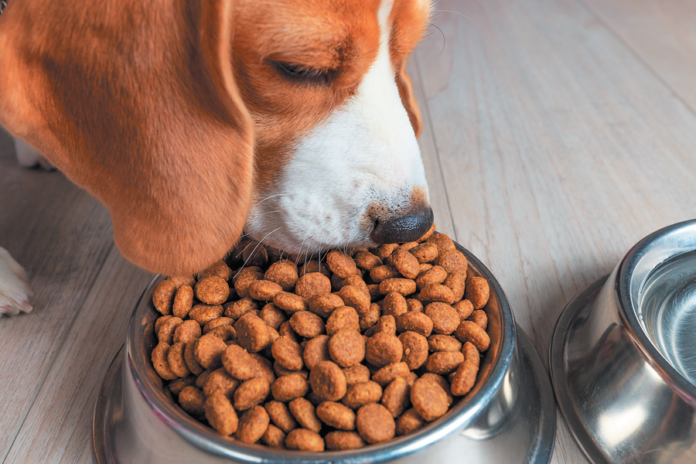Urinary stones in dogs not only cause pain. In severe enough cases, they can lead to a complete blockage of urine flow — a life-or-death emergency.
The good news: often, dietary measures can dissolve a stone in your dog’s urinary tract and help prevent future stone recurrence. Here’s a rundown of the three major types of stones suffered by dogs; what materials they’re composed of; which breeds are most likely to be affected (although any breed can get any type of stone); and how to treat them.
Struvite
Prevalence: Most common of all canine urinary stones; about 40 percent of dogs’ urinary stones are struvite.
Stone components: magnesium, ammonium, phosphate.
Breeds most commonly affected: Breed rarely plays a role in diagnosis, although the miniature schnauzer, bichon frise, miniature poodle, and cocker spaniel have sometimes been mentioned.
Most struvite stones are the result of a urinary tract infection. Not all UTIs can cause stones; there need to be certain types of bacteria involved.
You can dissolve the stone with diet (while concurrently treating the infection). The veterinarian will prescribe a therapeutic diet, typically one that can be purchased only with his or her approval. The food will have been tested to ensure that it has the right combination of nutrients to dissolve the stone.
An alternative is to have the stone removed surgically, also while treating the infection. You just have to watch for recurrence of the clinical signs, which could indicate that another stone has formed.
Once the stone has dissolved and the infection has cleared, the dog can return to her routine meal plan. Despite some people’s belief, a long-term diet change is almost never required for ongoing prevention of dogs with struvite stones.
Calcium Oxalate
Prevalence: A little less than 40 percent of urinary stones in dogs are made of calcium oxalate.
Stone components: calcium, oxalate.
Breeds most commonly affected: Bichon frise, miniature schnauzer, Lhasa apso, Yorkshire terrier, shih tzu.
Calcium oxalate stones are not dissolvable with diet. They must either be removed surgically, broken up with laser lithotripsy (a laser divides the stones into smaller pieces), extracted manually via cytoscopy (insertion of a flexible tube through the urethra and into the bladder), or, if small enough, expressed from the bladder in a process called voiding hydropulsion. However, you can decrease the risk for recurrence with dietary manipulation. And that’s important, because calcium oxalate stones do often recur. A number of therapeutic diets have been formulated for this purpose, with less of the calcium and oxalate that form the stones.
Note that a therapeutic diet for calcium oxalate stones may not be ideal for all dogs who have had the problem. Many calcium oxalate prevention diets are high in sodium, which is a concern for dogs with heart disease or high blood pressure. And they tend to be moderate or even high in fat — not good for dogs such as those with a history of pancreatitis, which is common in similar breeds.
Fortunately, manufacturers have started to make therapeutic diets that are appropriate for both stone prevention and other common health issues. Your veterinarian can help you choose the most appropriate therapeutic diet for your dog.
Urate
Prevalence: About 6 percent of urinary stones.
Stone components: urates (metabolic products made from purines, which are found in DNA and many other important molecules).
Breeds most commonly affected: Dalmatian, English bulldog, Jack Russel terrier.
Urate stones, like struvite stones, can either be surgically removed or dissolved using a special low-purine diet combined with a specific medication (allopurinol). Many breeds have a lifetime predisposition to developing these types of stones. To prevent recurrence, a diet low in purines must be fed permanently. Purines are highest in organ meats and muscle meat and lowest in dairy products, eggs, and plants, so your veterinarian may recommend a carefully supervised meat-free therapeutic diet.
Some dogs develop urate stones due to a congenital defect known as a portosystemic shunt — a condition in which a blood vessel takes blood around the liver rather than through it. If the shunt can be fixed surgically, the development of urate stones may no longer be an issue.
Signs of a Urinary Stone
Think of iced tea. You put a little sugar in, and it dissolves. But if you add too much, the solution becomes saturated, and sugar crystals sit in the bottom of the glass. That’s how it is with urinary stones. If there are enough of the stone components in the urine, they will not remain dissolved and will combine to form crystals and stones within the kidney or bladder.
Dogs with stones can have a variety of symptoms that look similar to a urinary tract infection: straining to urinate, urinating frequently, blood in the urine, and repeatedly turning and looking at the abdomen and hindquarters and exhibiting a pained expression. Sometimes the first sign is an inability to urinate altogether because a stone completely blocks urine flow. That’s an emergency that requires an urgent trip to the hospital.
Key for avoiding recurrence of any type of stone is a lifelong diet that includes a lot of water in order to create a very dilute urine. You should add quite a bit of water even to canned dog food and keep refreshing your pet’s water bowl with cold water to make it more enticing.





